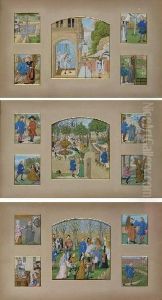William Burges Paintings
William Burges was an English architect and designer, one of the most prominent figures in the Victorian Gothic revival movement. Born on December 2, 1827, in London, England, Burges grew up in a period heavily influenced by the Gothic Revival, an architectural movement that sought to revive medieval Gothic architecture in contrast to the neoclassical styles prevalent in the 18th century. Burges studied at King's College London and later at the Royal Academy Schools, where he honed his skills in architecture. His education and early career coincided with a burgeoning interest in medieval art and architecture, significantly influencing his later work.
Burges's architectural and design career is notable for its dedication to the medieval Gothic style, his use of rich colors, and intricate detailing. He was not just an architect but also a designer of furniture, jewelry, and stained glass, emphasizing the unity of all arts within an architectural context. One of his most famous works is Cardiff Castle in Wales, where he transformed a conventional mansion into a Gothic Revival fantasy, incorporating elaborate murals, stained glass, and woodwork. Another significant project was Castell Coch, also in Wales, where he applied his imaginative and romantic vision of the Middle Ages.
Despite his talents, Burges's work was not universally appreciated during his lifetime. His designs were often seen as overly extravagant and whimsical at a time when tastes were shifting towards more restrained aesthetic principles. However, his work gained considerable recognition and appreciation posthumously, with many of his buildings now recognized as masterpieces of the Gothic Revival. Burges's influence extended beyond his immediate works; he inspired a generation of architects and designers who sought to integrate art and architecture comprehensively.
William Burges passed away on April 20, 1881, leaving behind a legacy that deeply impacted Victorian architecture and design. His commitment to the Gothic Revival and his holistic approach to design—encompassing architecture, furniture, and decorative arts—have cemented his place as a significant figure in the history of British art and architecture.

